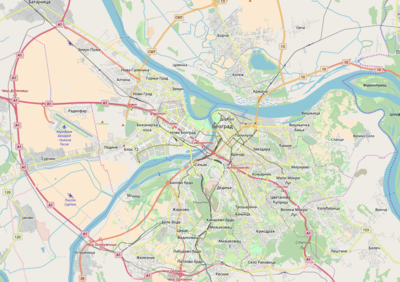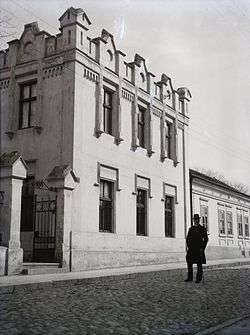Krunski Venac
Krunski Venac (Serbian: Крунски Венац) is an urban neighborhood of Belgrade, the capital of Serbia. It is located in Belgrade's municipality of Vračar.
Krunski Venac Крунски Венац | |
|---|---|
 Krunski Venac Location within Belgrade | |
| Coordinates: 44.804497°N 20.471250°E | |
| Country | |
| Region | Belgrade |
| Municipality | Vračar |
| Time zone | UTC+1 (CET) |
| • Summer (DST) | UTC+2 (CEST) |
| Area code | +381(0)11 |
| Car plates | BG |

Location
Krunski Venac is located along the Krunska street after which the neighborhood got its name (Serbian for "crown street"), in the northern part of Vračar, stretches to the neighborhood of Kalenić.[1]
History
19th century
At the corner of modern Krunska and Kneza Miloša streets, Jevrem Obrenović, brother of the ruling prince Miloš Obrenović, built the large house in the first half of the 19th century, and the spacious flower garden. Kept by his wife Tomanija, it was considered the most beautiful private garden in Belgrade at the time. The plants were imported from Turkey, Wallachia, Austria and France. In time, the area became known among the Belgraders as the "Corner at Mrs. Tomanija". The residence itself became the center of the cultural events in the city and one of the most visited houses in Belgrade.[2]
In 1880s, the later famous kafana Tri lista duvana ("Three tobacco leaves") was opened on the corner of the Kneza Miloša street and Bulevar Kralja Aleksandra. A bit later, the first telephone exchange in Belgrade was installed in the venue.[3]
20th century
One of the best preserved sections of "Old Belgrade", Krunska Street is considered to be one of the most distinguished areas in Belgrade, after the Civil Engineering Law from 1900 allowed only villa-type houses to be built in the area of Krunski Venac. From 1900 to 1903 the street was named after queen Draga.[4]
In 1920, the Society for the Construction of Catholic Church in Belgrade was founded. Since 1924 it has been headed by the archbishop of Belgrade Ivan Rafael Rodić who organized numerous charity gatherings to collect funds for the future Roman Catholic cathedral in Belgrade. City administration donated the parcel in Krunski Venac, bounded by the streets of Kičevska, Mileševska and Sinđelićeva, or roughly where the modern Park Vojvoda Petar Bojović is today. The Archdiocese was very satisfied with the location of the land lot, however the problem of ownership surfaced. The city donated the lot which he didn't officially own, so the plans failed, causing severe protests by both the Society and the Archdiocese. Collected money was then used to expand the Saint Ladislav Chapel in 1925-1926, which since 1924 functioned as the temporary cathedral of the Archdiocese. Proper Roman Catholic cathedral in Belgrade, after continuous failed offering of various locations during the Interbellum, was ultimately never built.[5]
21st century
The name of the neighbourhood, just like the adjoining Grantovac, later fell into obscurity and is not used much today. One of the rare official usage is for one of the exchanges of Telekom Srbija, until it resurfaced in the late 2010s in the media, regarding demolitions in the neighborhood.
In August 2018 part of the neighborhood was placed under the protection.[6] Concurrently, private investors announced partial demolition of the eastern section of the neighborhood (around the streets of Topolska, Petrovgradska and Vojvode Dragomira) and construction of several highrise buildings in the area. Inhabitants of Vračar organized, protesting against the project and stressing the necessity of preserving such refined ambient entireties. Architect Bojan Kovačević, president of the Serbian Academy of Architecture, said that "there are parts of the city which are docile units, and which can't resist the pressures from the investors. In the Topolska Street, someone is trying to capitalize on the ambient fineness by constructing the buildings which kill that very fineness".[7] Deputy mayor Goran Vesić said that he supports the motion for preserving the old neighborhood.[6]
Still, the demolition began. In September 2018, the 1927 villa, designed by Milan Štangl, was demolished. It was considered one of the earliest representatives of the moderna in Belgrade. It was demolished to make way for a residential building.[8] Only after it was demolished, the city decided to draft the detailed regulatory plan for the eastern section of the neighborhood which stipulates that the façades of the new buildings must be in accordance with the "ambient unit" of the neighborhood, and can't have modern glass-like façades, for example.[9]
At Resavska 25, just below the crossing with the Krunska, there was a House of Pera Velimirović, built in 1908. Two-floor house was designed by Jovan Ilkić for prime minister Petar Velimirović. Despite the house was placed under the preliminary protection as the future cultural monument, it was demolished in June 2020 by the private investors. Public and architects were outraged, director the Institute for the Protection of Cultural Monuments claimed that the investors had no green light to do it, other members of the Institute stated that the director issued the permit for demolition on her own breaking the law, but the building was leveled to the ground anyway to make room for the generic commercial building.[10][11][12]
Characteristics
Nikola Tesla Museum
The Nikola Tesla Museum is located in the neighbourhood. On 12 July 2007 Tesla's fountain was opened on a lawn outside the Museum, marking the 115th anniversary of the "Belgrade Waterworks", the city's official plumbing and sewage company. It was made after the original project of Nikola Tesla, patented in 1913, using a pump which uses very little electricity. It took 25 years for researchers to fully understand Tesla's idea and create a fountain like this. At the time, Tesla collaborated on the design of the fountain with the famed US stained glass artist Louis Comfort Tiffany.[13]
Students Polyclinic
On the corner with the Braće Nedić street, one of the "most elegant" buildings in Belgrade was built in 1923/24, with the purpose of being the largest and the most modern privately owned health institute in the Balkans. During the heavy „Easter bombing“ of Belgrade by the Allies on 16 April 1944. the hospital was hit and over 50 people were killed, including 22 mothers and 22 newborns, several visiting family members and several medical workers. Since the mid 1950s the "Institute for the student's health protection Belgrade" has been located in the building, which is colloquially known as the Students' polyclinic. Memorial plaque for the 1944 event was dedicated on 16 May 2017.[14]
References
- Miloš Lazić (12 June 2018). "Kafana po glavi stanovnika" [Kafana per capita]. Politika (in Serbian). p. 15.
- Goran Vesić (4 February 2020). Варош београдска [Belgrade town]. Politika (in Serbian). p. 16.
- Goran Vesić (14 September 2018). "Прва европска кафана - у Београду" [First European kafana - in Belgrade]. Politika (in Serbian). p. 12.
- Marija Brakočević & Dejan Aleksić (21 February 2016). "Bulevar kralja Aleksandra – moderna avenija sa šarmom prošlosti" (in Serbian). Politika.
- Goran Vesić (20 March 2020). Католичка катедрала које нема [Catholic cathedral which doesn't exist]. Politika (in Serbian). p. 14.
- Beoinfo (4 September 2018). "Vesić: Podržavam zahtev, sačuvati ambijentalne celine grada" [Vesić: I support the motion, we should preserve the ambient parts of the city] (in Serbian). N1.
- "Kovačević: Pitomi delovi grada pod pritiskom investitora" [Kovačević: Docile parts of the city under the investors' pressure] (in Serbian). N1. 27 August 2018.
- N1, FoNet (12 September 2018). "Počelo rušenje vile iz 1927. godine u Topolskoj" [Demolition of the 1927 villa in Topolska began] (in Serbian). N1.
- Branka Vasiljević, Dejan Aleksić (26 September 2018). "Престоница добија предуѕеће за метро" [Capital got a subway company]. Politika (in Serbian). p. 14.
- Milica Rilak (16 June 2020). "Počelo rušenje kuće u Resavskoj: Kome treba kulturno nasleđe" [Demolition of house in Resavska began: who needs cultural heritage anyway] (in Serbian). Nova S.
- Milena Ilić Mirković (19 June 2020). "Nastavljeno rušenje u Resavskoj: "Nestaje istorija Beograda"" [Demolition in Resavska continued: "Belgrade's history disappearing"] (in Serbian). Nova S.
- Milan Janković (22 June 2020). Један од пет - Рушење културе [1 to 5 - Demolition of culture]. Politika (in Serbian). p. 14.
- Politika daily, July 13, 2007, page 44
- A.V. (17 May 2017), "Devet i po decemija poliklinike u Krunskoj", Politika (in Serbian), p. 17